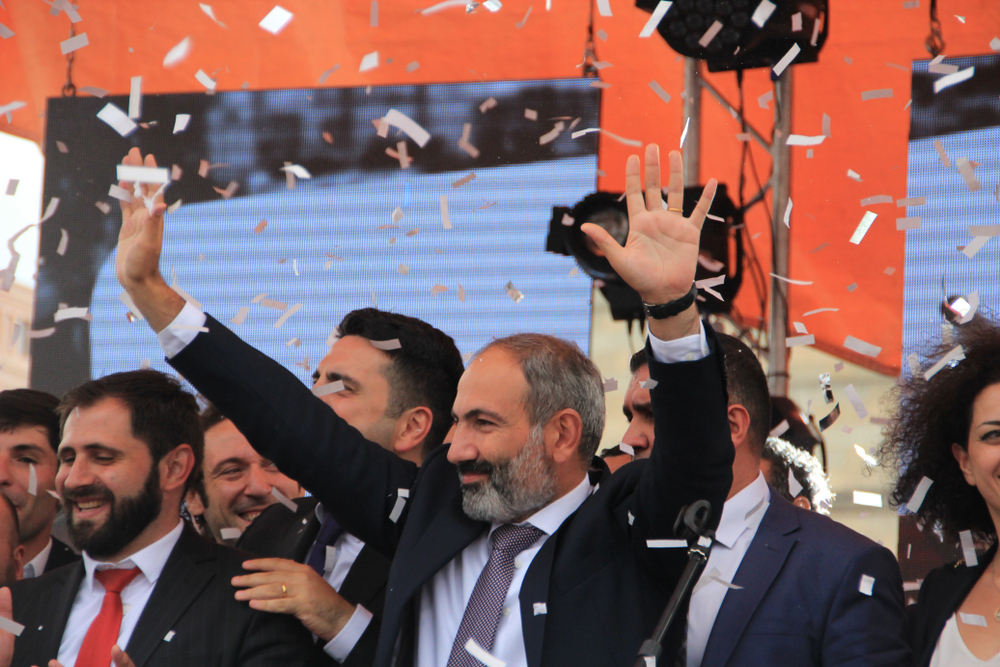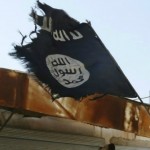by Olesya Vartanyan
One of the windows in Sonya Matinyan’s home is filled in with bricks. The glass of the other is splintered by a rifle bullet. The roof has taken a few missile hits and leaking water has stained the ceilings in the interior. But, unusually, the 57-year-old Armenian is staying home this winter.
That’s because things are changing for the better in Berkaber, on Armenia’s north-eastern border with Azerbaijan. No gunfire has sounded here in the region of Tavush for almost two months, a welcome change from clashes that in the past two winters drove inhabitants into fortified cellars or to distant relatives’ homes. The quiet marks a rare lull in an area that has suffered conflict since the collapse of the Soviet Union in 1991, when the two countries drove out each other’s Azeri and Armenian minorities and Armenians seized the nearby region of Nagorno-Karabakh and seven surrounding districts from Azerbaijani control.

The recent improvement is in large part thanks to Nikol Pashinyan, a once marginal former journalist who in April led demonstrations that swept aside the old Armenian leadership. He confirmed his primacy on December 9, when his My Step political alliance won snap parliamentary elections. The former ruling Republican party failed even to pass the 5% threshold to enter parliament. The poll was one of the freest and fairest in the recent country’s history, most observers said.
The longest truce in almost fifteen years is also holding because the leaders of Armenia and Azerbaijan agreed to communicate without intermediaries in September. In mid-November, defense officials of both countries met to finalize restoring direct lines of communication between military units located along Armenia’s southern border with Nakhchivan, an autonomous exclave of Azerbaijan.
Armenia’s “Velvet Revolution”
The December 9 election concludes a period of transition since Armenia’s “velvet revolution” in April. The new ruling alliance has a disparate membership. Its backbone is a handful of people who stood next to Pashinyan in his small and once unimportant opposition party, Civil Contract. This group has been joined by other leaders of the street protests that led to the resignation of former president and subsequent prime minister, Serzh Sargsyan. Some members of Pashinyan’s team know the complexities of the Nagorno-Karabakh conflict from years of work in civil society organizations and meetings with Azerbaijani experts.
The new parliament’s first session will convene in the coming weeks to endorse Pashinyan as prime minister. With a strong parliamentary majority, Pashinyan and his team will face fewer barriers to initiating new legislation and reforms. The public expects swift improvements in how ruling elites govern, an end to corruption and more incentives for small businesses. People, particularly those directly affected, also want to see progress on resolving the Nagorno-Karabakh conflict.
“Maybe he doesn’t have a magic wand to fix everything at once”, says 47-year-old Armen Markaryan two weeks before the election. He came to listen to Pashinyan at a pre-election meeting with voters in the town of Ijevan, the main town in Tavush and only about 20 kilometers from the military trenches at the border with Azerbaijan. “But he has to change something so that we can live better and without war,” Armen said.
A Complex Peace Process
Pashinyan’s team has been publicly cautious about its plans regarding Armenia’s conflict with Azerbaijan. Throughout the election campaign, the former ruling Republican Party attacked the Pashinyan alliance as “traitors” preparing a “criminal conspiracy” with Baku. They based their attacks less on what Pashinyan has said than on the young age of many members of his ruling team and their lack of personal connections to Nagorno-Karabakh and the war in this region in the 1990s – in contrast to previous Armenian leaders. Pashinyan’s entourage reject the accusations of selling out.
Official negotiations have been dormant for several years. An April 2016 flare-up in Nagorno-Karabakh killed at least 200 soldiers and civilians on both sides, after which divisions deepened as the parties started making maximalist demands. Azerbaijan calls for the immediate return of the seven regions surrounding Nagorno-Karabakh, which have been under Armenian control since the early 1990s. Armenia, on the other hand, insists that the first step should be for Baku to grant independence to Nagorno-Karabakh.
The new ruling team in Armenia recognizes that there is no easy way out of this impasse. “Everyone understands that a ‘reset’ is needed,” one of the newly elected parliamentarians of Pashinyan’s political alliance said, suggesting that both sides need to take steps to escape the years-long deadlock in talks. “But in order to launch such a reset, we must first reach a consensus within the party and the government”.
In August, speaking at a rally to celebrate his first 100 days of his office, Pashinyan promised tens of thousands of people gathered in the center of Yerevan to turn to them for support before any settlement on Nagorno-Karabakh. The promise means that “Armenia will not make any sudden moves in the negotiation process any time soon,” said another newly elected parliamentarian from Pashinyan’s political alliance, suggesting that there will be no sudden change to its core demand on Nagorno-Karabakh’s status.
Courting Azerbaijan
The new Armenian government will have to convince not only its own population, but also Azerbaijan, that a serious path to peace exists. For a number of years, the Azerbaijani government has called for substantial talks that will bring real change – by which it means the return of lands surrounding Nagorno-Karabakh seized by the Armenian side in the war with Azerbaijan in 1992-1994. Pashinyan would have to find a way to convince Baku that his government is ready to engage in good faith. Many on both sides doubt the other’s intentions and question whether a ceasefire can be maintained. The relative calm since September follows years of steadily increasing casualties along the frontlines and military build-ups in both countries.
There are signs of optimism on the Azerbaijani side too, however. Crisis Group’s interlocutors in Baku insist that Azerbaijan maintains the truce in the hope that the direct line of communication will pave the way for genuine negotiations with the new Armenian leadership. On 5 December, the Armenian and Azerbaijani foreign ministers held their third meeting since Armenia’s April revolution. Talks between the leaders could follow.
While keeping the frontlines quiet is critical to achieving any ‘reset’ of peace talks, additional confidence-building measures would also help, including opening other lines of direct communication parallel to the military one. High-ranking Armenian officials told Crisis Group that establishing such links between humanitarian actors on both sides, for example, would be helpful. Representatives of Azerbaijan voiced similar ideas.
The two sides have already taken steps in this direction, using the military communication channel to discuss the possible release of an Armenian resident arrested in the country’s north-east state border area by Azerbaijani authorities since summer. On 5 December, the de facto Nagorno-Karabakh authorities stated that they were ready to consider releasing an Azerbaijani soldier detained in Stepanakert since the beginning of 2017. Such discussions should continue.
A More People-centred Approach
The new government in Armenia might also bring some fresh thinking on the conflict. According to one newly elected Armenian parliamentarian from Pashinyan’s party: “We can change our approach. Instead of discussing only political demands, we could begin to focus more on people and their needs, from two sides.”
A high-ranking Armenian diplomat also told Crisis Group that he hopes that such a “people-oriented approach” would dominate the negotiation process. Opportunities to discuss concessions may arise, but “it is important to recognize that Nagorno-Karabakh is about the people, not just the conflict.”
The current ceasefire serves the interests of large numbers of people on both sides. 600,000 Azerbaijanis reside within fifteen kilometers of the Nagorno-Karabakh frontlines. Similarly, tens of thousands of people live near the borders of Armenia and Azerbaijan, including around 40,000 permanently residing close to military zones in Armenia’s Tavush region, where frontline trenches stretch for 230 kilometers through the mountains.
In places like Tavush, more communication could help the parties coordinate on demining civilian roads and farm plots close to the frontlines, even before issues at the core of the conflict are discussed. The same applies to Azerbaijani villages, including along the frontlines in the Nagorno-Karabakh conflict zone. The two sides could start by marking the minefields left over from the early 1990s war. They could then demine any land that has no strategic military value and hand it over to civilians.
New security guarantees would also allow frontline residents to return to work on agricultural plots close to military positions. In the past four years, skirmishes have forced farmers to abandon fields in at least six villages in Tavush, residents told Crisis Group. For many of them, agriculture is the only way to make ends meet.
“This year, for the first time, people began to go swimming in the reservoir,” said Berkaber resident Argam Arzumanyan. Before the war, his village was a favorite vacation spot for people from Armenia, Azerbaijan and even neighboring Georgia. Now military fortifications start only 20m away from each side of the dam. The last time the villagers had the courage to go down to the water was back in 2004. This year, Argam says, “I looked at the people splashing around in the water and could not believe my eyes and asked myself: are we really starting to live without war again?”
Olesya Vartanyan is an analyst with the International Crisis Group, where this article originally appeared.






The Armenian-Azerbaijani Nagorno-Karabakh conflict has been a potential threat to the region’s stability for 30 years. Every day the Armenian Armed Forces violate the ceasefire several times and the civilian residents living in border areas are suffering from it. Despite the resolutions adopted by international organizations, Armenia has not yet abandoned its occupation policy.
Today, Armenia’s inadequate steps, actions, and high-ranking statements make this country even more difficult. Despite all this, Azerbaijan acts as a supporter of the world and gives Armenia a chance. Because it does not want bloodshed. Nagorno-Karabakh will never get any status outside Azerbaijan’s sovereignty. The Azerbaijani people and the state will never let its legacy, history, legal land leave him.